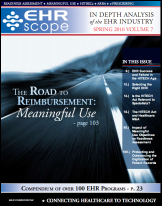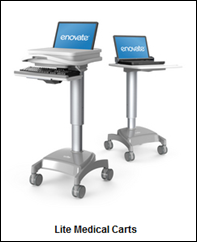I like much of what you wrote, with one exception: AI. I'd make AI a marketing highlight of the new…
News 2/17/10
From Nurse: “Re: Community Hospital South (IN). The CEO has announced that the hospital’s problems with GE Centricity Enterprise going back to August will cause it go back to the old GE CIS inpatient system next month. Deployment of Centricity Enterprise is on an indefinite hold.” Unverified, but the e-mail snips included look genuine. Maybe this would have convinced them to stay on: GE Healthcare announces that Centricity Enterprise EMR is now in the ecoimagination portfolio, which the announcement claims was “rigorously tested in-house and by a third party in order to provide optimal satisfaction to GE clients.”
From Kate: “Re: B52s. Who’s having them? I need to crash.” It’s an invitation-only HIMSS event (which I know only because I was invited), so I blurred the vendor name. Cindy and Kate were warbling hotties back in the day, although they are now 52 and 61, respectively, so they may not hop around like they used to. If I were this vendor’s customer and not planning to attend the HIStalk event (whaaaat?) then I’d probably check them out since I can sing along badly with all of Cosmic Thing, especially Deadbeat Club and Dry County, with a few beers in me.
From Zippy: “Re: articles in Racine, WI paper about All Saints. Doctors are not happy with administration and a number may leave.” Doctors and administrators are feuding, with a third of the medical staff ready to bolt. The final straw, apparently, was the hospital’s contracting with a Florida anesthesia company, replacing a local group after failing to reach an agreement about pay, on-call policies, and the use of nurse anesthetists. Also noted as a key issue: the 2009 introduction of an EMR system, which the doctors complain wasn’t well supported.
From Wake Up: “Re: McKesson’s problems. All listed before: HERM cost $150 million and still isn’t ready for prime time, ambulatory and HAC are a shambles, the 10.xxx upgrade is needed for meaningful use, but is painful for customers,and the company likes to replace quality employees with green beans.” All unverified, although I’ve heard them all before, usually from disgruntled former employees. Others have speculated that Pam’s downfall involved ongoing Horizon Clinicals integration struggles, of which ER 10 was an early warning of the challenges ahead (not surprising since all of those apps were developed by different acquired companies, as I remember: Vanderbilt, CliniCom, HCS, and others I’m forgetting). On the other hand, I’ve talked to one HERM site so far and they had nothing at all bad to say, other than to observe that the requirement to upgrade to Horizon Clinicals ER 10 wasn’t clearly stated upfront. I’m trying to connect with a second site.
From Stealth: “Re: Oracle’s Sun Division. I heard an unconfirmed rumor that it’s about to announce that it’s not going to support its JCAPS for EGate interface engine. Has anyone heard this?”
From G-Dog: “Re: articles. I thought this article might be worth discussing on HIStalk.” It covers board certification in informatics for physicians, with the authors concluding that it’s not really like other subspecialties since it covers all other specialties to some degree. AMIA is hoping initial review by ABMS will happen next year or the year after.
From The PACS Designer: “Re: Pogo Stylus. iPhone apps and other new mobile phone accessories keep getting innovative and the Pogo Stylus from TenOneDesign is the latest innovation. You can use the stylus to be creative and design artful stuff. Perhaps, we can get postings from Inga using the Pogo Stylus on her iPhone to entertain us HIStalkers, while Mr. H. uses his BlackBerry to organize HIMSS 2010 entertainment!” It’s $14.95.
The lab division of Fresenius Medical Care North America goes live on McKesson Horizon Lab.
EHRScope releases its Spring 2010 issue (warning: PDF). I really like this publication since it’s a lot meatier than the fluff the rags usually run, with some thoughtful articles and editorials.
This article describes a study in which researchers used CDC’s diagnostic algorithms for acute hepatitis B to search 16 years’ of ambulatory EMR data. It found 112 of the known 113 positive patients, but also detected an additional eight cases, four of which had not been reported to the health department. The next step (obviously) would be to turn those algorithms into real-time alerts.
Duke University Hospital chooses Simplifi 797 IV compounding QA software.
Fallon Clinic (MA) cites several improvements in making Dragon Medical part of its EHR implementation.
Jobs: EHR Project Manager (CA), Systems Administrator (AZ), Senior Systems Analyst (GA).
Sleep well knowing that Weird News Andy is guarding the gate. He finds this article, with the key line being, “Each time the two had sex, documents say, the doctor would bill her Blue Cross Blue Shield Insurance for their ‘sessions’.” The psychologist involved, who called himself RHL (short for Red Hot Lover), is being sued by his former lover and investigated by the state. WNA also likes this story (he threw in a Subway $5 foot long pun at no extra charge) about surgeons in Czech Republic who left a foot-long medical tool in a patient’s abdomen after surgery, which stayed there until five months later.
Former Eclipsys VP Charles Tuchinda, MD is named chief innovation officer, healthcare of Hearst Business Media. He’ll also be a VP at properties Zynx Health and First DataBank.
iSoft will distribute iMDsoft’s MetaVision suite in Germany. It offers clinical decision support, CPOE, and reporting for critical care environments. Among its customers, iMDsoft has four of the top 10 US hospitals at 13 of the top 50 European hospitals, with a 100% retention rate in its 11 years. Coincidentally, I’ve got an interview coming as soon as I have time to post it.
Orion Health gets some coverage of its recent large sales in the New Zealand business paper.
An ED doctor’s article in an Australian medical journal urges that hospital executives who fake quality data be prosecuted the same as corporate book-cookers. He claims that hospitals have submitted phony data ever since they started getting paid for performance, including discharging patients electronically and then re-admitting them to hit quality targets.
Odd lawsuit: a patient care tech brings a baby to the hospitalized mom of a newborn. The mom starts breast-feeding the baby, but a nurse walks in to tell her it’s the wrong baby. The mother is suing Evanston Hospital and its parent corporation, even though no harm was done and even though she herself didn’t notice (she says she couldn’t see in the dark). The tech apologized in tears, but the father said, “It’s not enough”.
HERtalk by Inga
From Forest Green: “Re: Sage again. I just heard of another executive departure — Kat Henry, SVP of customer service. I hope the new president can turn things around for them!” Sage has confirmed.
From George Geef: “Re: patient survey. Obviously, we don’t quite agree with the ‘goofy’ categorization of the GfK Roper survey. Compared with the CDC and NEJM surveys, actual patients witnessing computers being used for charting seems to me more accurate gauge of the shift than doctors self-reporting on partial or full use of EMRs.” OK, goofy was not the most eloquent and descriptive word I could have used. Let’s just say I am suspect of the conclusions drawn. Just because a patient notices a PC does not mean the practice has an EMR. The study also noted that older and wealthier patients said their doctors have EMRs more often than younger and poorer patients, concluding that doctors treating older and wealthier patients are more likely to have EMRs. Perhaps, though I could come up with a few other equally plausible conclusions.
Yesterday I came across a mention of HIStalk on a one of our reader’s blogs. The writer’s note made Mr. H and me smile: “I am anxiously awaiting my annual trip to HIMSS. Should be interesting to see what companies are doing around ARRA. At least CCHIT finally released their test scripts today so that there can be a lot of buzz. I especially can’t wait to go to the HIStalk reception. It has been the highlight of the trip the last 2 years.” I have to admit it’s been a highlight for me as well.
After six years of no price increases, Surescripts drops the price of its e-prescribing services for pharmacies, pharmacy vendors, and pharmacy benefits managers. Surescripts says the move is part of its ongoing commitment to improve operational efficiencies and the result of economies of scale. And I bet Surescripts found a price adjustment was necessary in order to remain competitive since the market is a bit more crowded than it was six years ago.
Speaking of Surescripts, the company sets up an advisory committee to help with the development of a prescription history service for HIEs. Committee members include the heads of five HIEs.
Members of a federal HIT advisory group recommend relaxing the number of measures required for providers to demonstrate meaningful use of EHRs. The group wants to drop up to six MU measures for 2011, which still leaves about 80% of the measures originally proposed. The advisory group says the currently proposed 2011 measures set the bar too high, making it difficult for providers hoping to qualify for 2011 stimulus money.
Coming soon: a new post in our ongoing vendor executive series on HIStalk Practice. Several dozen industry CEOs provide answers to the following question: In addition to ARRA-related items, what will be some of the hot topics at HIMSS this year? The insights are diverse and include musings on interoperability, rapid deployment of EHR systems, data collection, mobility, and industry alliances and consolidations. If you’d like to receive a notification when the series is posted, make sure you are signed up as a HIStalk Practice subscriber.
I have to admit I found this press release a bit opportunistic — or at least cheesy. After four introductory paragraphs detailing the Olympic and professional accomplishments of speed skater Eric Heiden, it becomes obvious the piece is really an ad for the records management software used in Heiden’s orthopedic practice. To fully appreciate the message, I think you need to imagine Jim McKay saying these words:
Just as athletes benefit from high-tech gear, clothing and equipment that enables them to be faster, better, stronger, Heiden says Records Studio utilizes superior technology to help optimize the performance of all departments of his medical practice, not just patient care.
East Orange General Hospital (NJ) purchases GE Centricity Enterprise for its hospital-based EMR. GE’s data center will provide the hospital with remote application hosting.
Enovate releases its Enovate Lite Medical Cart services, which includes CompactLite, StandardLite, and UltraLite models. I see the Enovate guys will be showing off the new cart at HIMSS.
Kaiser Permanente reports 2009 net income of $2.1 billion, which is a vast improvement over 2008’s net loss of $794 million. Q4 net income was $214 million, which more than doubles 2008’s number. The turnaround was largely the result of improved financial markets. Meanwhile, membership numbers fell by 64,000 in 2009 after falling 30,000 the year before. Total membership is 8.58 million.
Nemours/Alfred I. duPont Hospital for Children (DE) goes live on GetWell Town, the pediatric version of GetWellNetwork’s Interactive Patient Care system.
The Camden Coalition of Healthcare Providers (NJ) selects Noteworthy Medical Systems to be the information hub for their multi-hospital HIE.
Mediware announces that Oregon Health Sciences University will implement its BloodSafe system.
MEDecision launches a new collaborative HIE service called InFrame that facilitates clinical data sharing, including diagnostic quality medical images.











I love my Pogo Stylus. Women with nails of any length need one of these. I keep a couple in my handbag as spares. And the handy clip attachment rocks.
I thought Nemours/Alfred I. duPont Hospital for Children was in DE?
[From Inga] My mistake. The press release actually didn’t say where the hospital was. Maryland is actually where the vendor is located.
Czechoslovakia no longer exists!
[From Mr. HIStalk] It does in my mind, apparently (see: typical American with minimal geographic intelligence). Corrected. I wonder if constantly changing countries are good or bad for makers of globes? Or does anyone buy globes anyway knowing they are obsolete almost instantly?
Zippy in reports about Racine All Saints, the news states: “Also noted as a key issue: the 2009 introduction of an EMR system, which the doctors complain wasn’t well supported.” I heard that before and frequently. Gee, I heard that that hospital has McKesson’s EMR. You may omit that last sentence if not true.
[From Mr. HIStalk] I interpreted that comment as being critical of the hospital’s local support of the medical staff, not the vendor’s support of the hospital.
RE: Globes…Yes, and Reploge would have been happy to give a tour of the globe factory as a get-away from the just awful HIMSS experience you described in Chicago…along the way you could have stopped into a couple burger and dog dives on Roosevelt Road that take grease to a whole new level of biohazard…these find their reason for being in the staff and patients just around the corner from the huge VA and Loyola campuses that are easily seen from outer space…
http://www.replogleglobes.com/
[From Mr. HIStalk] I should say, in the interest of fairness, that I thought HIMSS in Chicago was OK given the weather and the cost. It would be my least favorite HIMSS city of all I’ve been to (all of them since 1998 or so) but it wasn’t really all that bad. I never like the opening receptions — to much noise and effort just to wait in line for a couple of free drinks (from an ROI standpoint, it fails for me).